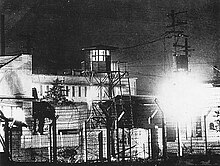Sugamo prison
Coordinates: 35 ° 43 ′ 46.5 ″ N , 139 ° 43 ′ 4 ″ E
The Sugamo Prison ( Sugamo Kōchi-sho , 巢 鴨 拘 置 所 ( Kyūjitai ), 巣 鴨 拘 置 所 ( Shinjitai )) was a Japanese detention center .
history
Sugamo Prison was built in Ikebukuro , part of what is now Tokyo 's Toshima district , in the 1920s . European prisons were the model for the construction. The prison was mainly used to house political prisoners such as dissidents or communists .
After Japan's surrender in World War II , it was used from 1945 onwards by the allied occupying powers (in fact the United States ) to imprison Japanese prisoners of war who were awaiting negotiations in the context of the Tokyo trials .
All Japanese category B and C war criminals who had been sentenced to prison terms by Allied military tribunals outside Japan (e.g. in the Dutch East Indies , Guam , New Guinea ) were transferred to the prison to serve their sentences. On December 23, 1948, 11 Category A war criminals were executed in Sugamo Prison . On July 4, 1957, all those who remained were pardoned.
Sugamo Prison was demolished in 1971 after all prisoners of war held there either died or were released. In 1978 the Sunshine 60 building, at that time the tallest building in Japan, was erected on this site . A stone with the inscription "Pray for Eternal Peace" was placed in memory of the former prison.
Detained in Sugamo Prison
Inmates at Sugamo Prison included:
- Tōjō Hideki , Prime Minister of Japan from 1941 to 1944,
- Koiso Kuniaki , Prime Minister of Japan from 1944 to 1945
- Iva Ikuko Toguri D'Aquino , also known as Orphan Ann , presenter at Radio Tokyo , employee of the Japanese war propaganda ,
- Honda Kumatarō , Ambassador to Germany and China
- Kodama Yoshio , Yakuza boss, shaped the structure of the Japanese political system in the 1950s
- Doihara Kenji , spy
- Ozaki Hotsumi , spy
- Richard Sorge , spy
- Willy Rudolf Foerster , industrialist, Nazi opponent and "savior of Jews"
It was the job of the 8th Army to detain all convicted Japanese war criminals (of all categories) during the occupation , especially those convicted of the Yokohama war crimes trials . These were housed in Sugamo . During the six years that the prison was under the 8th Army, a total of 2,450 soldiers served there .
literature
- John L. Ginn: Sugamo Prison, Tokyo. An Account of the Trial and Sentencing of Japanese War Criminals in 1948 . By a US participant. McFarland & Company, Jefferson NC et al. 1992, ISBN 0-89950-739-5 .
- Manfred Kittel: Sugamo wasn't Spandau. Comments on the judicial “coming to terms with the past” in Japan and Germany after 1945 . In: Michael Bienert (ed.): The four powers in Berlin. Contributions to Allied politics in the occupied city . Landesarchiv, Berlin 2007, ISBN 978-3-9803303-1-2 , ( series of publications by the Landesarchiv Berlin 9), pp. 147–158.
See also
Individual evidence
- ↑ Piccigallo, Philip; The Japanese on Trial; Austin 1979; ISBN 0-292-78033-8 (each in the chapters on the individual nations).
- ↑ Clemens Jochem: The Foerster case: The German-Japanese machine factory in Tokyo and the Jewish auxiliary committee Hentrich and Hentrich, Berlin 2017, p. 226 f., Note no. 135, ISBN 978-3-95565-225-8 .
- ↑ Piccigallo; Pp. 83-90.
- ^ Sugamo Prison Reunion Association ( Memento from December 1, 2004 in the Internet Archive )


